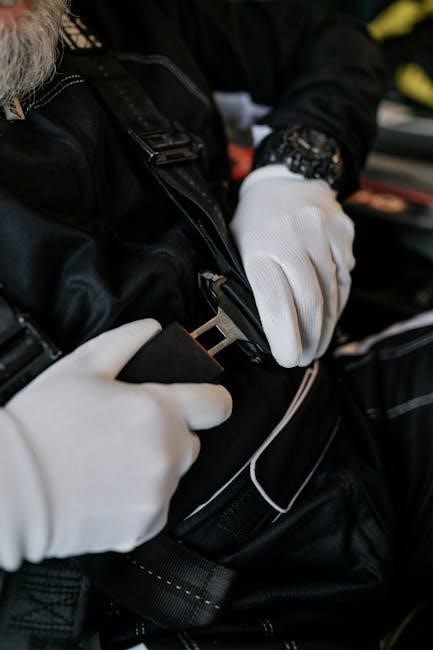Welcome to the Safety 1st car seat guide, designed to help you ensure your child’s safety and comfort while traveling. This comprehensive guide covers proper installation, usage, and maintenance tips for Safety 1st car seats, including rear-facing, forward-facing, and booster models. Follow these instructions carefully to secure your child safely and confidently on every journey.
Overview of Safety 1st Car Seats
Safety 1st offers a wide range of car seats designed to provide superior protection and comfort for children of all ages and sizes. Their product line includes rear-facing, forward-facing, and booster seats, each engineered with advanced safety features to meet rigorous testing standards. Models like the Grow and Go All-in-One and Alpha Omega 65 are popular choices, offering versatility and longevity as they adapt to a child’s growth. These seats are equipped with features such as adjustable harnesses, recline options, and top tethers for enhanced stability. Safety 1st car seats are known for their user-friendly designs, making installation and adjustment straightforward for parents. With clear instructions and robust construction, they prioritize both safety and convenience, ensuring peace of mind for families on the go.
Importance of Proper Installation and Use
Proper installation and use of a Safety 1st car seat are critical to ensuring your child’s safety while traveling. Incorrect installation can compromise the seat’s ability to protect your child in the event of an accident, potentially leading to serious harm. Following the manufacturer’s instructions closely is essential, as each model has specific guidelines tailored to its design and features. Correct use includes adhering to weight, height, and age limits, as well as proper harness and buckle techniques. Taking the time to install and use the car seat correctly provides optimal protection and peace of mind for parents, ensuring their child is safe and secure on every journey.

Key Considerations for Parents
Parents must consider their child’s age, size, and weight when choosing a Safety 1st car seat. Ensure the seat fits both the child and vehicle, adhering to all safety guidelines for proper use and installation.
Understanding Car Seat Types: Convertible, Infant, and Booster
Safety 1st offers three primary car seat types to accommodate your child’s growth: convertible, infant, and booster seats. Convertible seats transition from rear-facing to forward-facing, suitable for children from 5-40 lbs in rear-facing mode and up to 65 lbs in forward-facing. Infant seats are designed for newborns up to 40 lbs, providing a snug fit for smaller babies. Booster seats are for older children who outgrow forward-facing seats, ensuring proper seatbelt positioning. Each type is tailored to specific age, weight, and height ranges, ensuring your child’s safety and comfort as they grow.
- Convertible seats adapt to your child’s growth.
- Infant seats are ideal for newborns and younger babies.
- Booster seats ensure proper seatbelt fit for older children.
Choosing the Right Car Seat for Your Child’s Age and Size
Selecting the appropriate car seat for your child involves considering their age, weight, and height. Rear-facing seats are for infants up to 40 lbs or 40 inches tall, while forward-facing seats accommodate children over 22 lbs and 29 inches tall. Booster seats are for children who outgrow forward-facing seats but are still too small for adult seatbelts. Always refer to the manufacturer’s guidelines to ensure the seat meets your child’s specific needs. Proper fit ensures optimal safety and comfort, so choose a model that aligns with your child’s growth stage. Regularly check weight and height limits to transition to the next seat type when necessary.
- Rear-facing: Infants up to 40 lbs or 40 inches.
- Forward-facing: Children over 22 lbs and 29 inches.
- Booster seats: For children who outgrow forward-facing seats.
Weight and Height Limits for Safety 1st Car Seats
Safety 1st car seats have specific weight and height limits to ensure proper fit and safety for your child. Rear-facing seats typically accommodate children from 5 to 40 lbs (2.3-18 kg) and 19 to 40 inches (48-101.6 cm) tall. Forward-facing seats are designed for children weighing 22 to 65 lbs (10.1-29 kg) and measuring 29 to 49 inches (73.6-125 cm) tall. Booster seats are for children up to 80 lbs (36 kg) or 57 inches (145 cm) tall. Always check the user manual for exact specifications, as limits may vary by model. Adhering to these guidelines ensures your child is properly secured and protected while traveling.
- Rear-facing: 5-40 lbs, 19-40 inches.
- Forward-facing: 22-65 lbs, 29-49 inches.
- Booster: Up to 80 lbs or 57 inches.

Pre-Installation Steps
Before installing your Safety 1st car seat, read the user manual and vehicle manual to understand compatibility and requirements. Ensure the car seat and vehicle are prepared for a secure fit.
- Read both the car seat and vehicle manuals.
- Check weight and height limits.
- Prepare the vehicle seat for installation.
Reading the User Manual and Vehicle Manual
Reading both the Safety 1st car seat manual and your vehicle’s manual is crucial for a safe and correct installation. The car seat manual provides specific instructions for your model, including weight and height limits, installation methods, and harness adjustments. Your vehicle’s manual details the location of LATCH anchors, seat belt types, and other installation-related features. Understanding these documents ensures compatibility and proper use of safety features. Failure to follow instructions can compromise your child’s safety. Always check for updates or additional guidance on the Safety 1st website.
- Review weight and height limits for your car seat model.
- Locate LATCH anchors and seat belt routing paths in your vehicle.
- Understand proper harness and seat belt adjustments.
- Prepare your vehicle for installation by clearing the seating area.
Understanding LATCH and Seat Belt Compatibility
Understanding LATCH (Lower Anchors and Tethers for Children) and seat belt compatibility is essential for installing your Safety 1st car seat. The LATCH system provides a secure connection using built-in anchors in your vehicle, simplifying installation. However, check if your vehicle is equipped with LATCH and ensure it meets your car seat’s weight limits. If LATCH isn’t available or exceeds weight limits, use the seat belt method. Both methods ensure safety, but LATCH is often easier. Always refer to your car seat and vehicle manuals for compatibility details. Proper use of LATCH or seat belts guarantees a secure fit, protecting your child during travel.
Preparing the Vehicle for Car Seat Installation
Before installing your Safety 1st car seat, ensure your vehicle is properly prepared. Choose a safe location, preferably the middle seat, as it is farthest from impact zones. Clean the vehicle seat area to remove any debris that might interfere with the car seat’s fit. Adjust the vehicle seat to an upright position and remove any bulky items that could obstruct installation. If using a seat belt, ensure it is in good condition and free from twists. Check that the vehicle seat belt or LATCH anchors are accessible and compatible with your car seat. Finally, confirm that the car seat fits snugly in the vehicle, with no gaps that could compromise safety. Proper preparation ensures a secure installation for your child’s protection.
Rear-Facing Car Seat Installation
Place the Safety 1st car seat in the rear-facing position, ensuring it fits snugly in the vehicle. Use LATCH or a seat belt to secure it, checking the recline angle and base stability. Follow Safety 1st guidelines for a proper and secure fit.
Step-by-Step Guide to Rear-Facing Installation Using LATCH
Locate the LATCH anchors in your vehicle, typically found in the seat crease. Attach the LATCH connectors from the Safety 1st car seat base to these anchors.
Push the connectors firmly until they click, ensuring a secure connection. Tighten the straps by pulling them to remove any slack.
Check the recline angle using the built-in indicator or level line to ensure proper positioning for your child’s head and neck support.
Secure the car seat base snugly against the vehicle seat, ensuring no movement exceeds one inch side-to-side or front-to-back.
Finally, test the installation by gently tugging the car seat to confirm stability and proper placement for your child’s safety.
Installing Rear-Facing Car Seat with Seat Belt
Locate the rear-facing seat belt path on the Safety 1st car seat base.
Thread the vehicle’s seat belt through this path, ensuring it is correctly routed and free of twists.
Pull the seat belt fully extended and lock it by retracting it to engage the locking mechanism.
Tighten the belt by pulling it firmly to eliminate any slack, securing the car seat base snugly against the vehicle seat.
Check the car seat’s stability by gently tugging it; it should not move more than one inch in any direction.
Use the pinch test to ensure the harness is snug, with no excess webbing at the shoulders, for your child’s safety.
Refer to both your vehicle and car seat manuals for specific guidance on seat belt routing and locking mechanisms.
Achieving the Correct Recline Angle for Rear-Facing
Achieving the Correct Recline Angle for Rear-Facing
To ensure your child’s safety and comfort, the car seat must be installed at the correct recline angle when in rear-facing mode. Locate the recline indicator or level line on the Safety 1st car seat base, as this will guide you to the proper position. Adjust the recline handle or mechanism to tilt the seat until the indicator aligns with the marked level line. Once the correct angle is achieved, tighten the car seat base firmly to the vehicle seat to maintain stability. For added safety, gently rock the car seat from side to side and front to back to ensure it does not shift excessively. This step is critical for proper support of your child’s head and neck while rear-facing.
Securing the Car Seat Base
Securing the Car Seat Base
Securing the car seat base is a critical step to ensure your child’s safety. For Safety 1st car seats, attach the base to the vehicle seat using either the LATCH system or a seat belt. If using LATCH, connect the lower anchors to the base and tighten the straps until the base is snug. For seat belt installation, thread the belt through the base’s belt path and lock it in place. Once secured, check for stability by gently rocking the base—it should not move more than an inch side-to-side or front-to-back. Tighten the base further if necessary. Always consult the user manual for specific instructions tailored to your Safety 1st model. A properly secured base ensures optimal protection for your child during travel.
Forward-Facing Car Seat Installation
Install the Safety 1st car seat in forward-facing mode by securing it with LATCH or a seat belt. Attach the top tether for added stability and safety.
Transitioning to Forward-Facing: When and How
Transition your child to a forward-facing Safety 1st car seat when they exceed the rear-facing weight or height limit, typically around 40 pounds or 19-36 inches tall. Ensure your child is at least one year old and can walk unassisted. Before transitioning, consult the user manual for specific guidelines. Move the harness straps to above the shoulders and adjust the seat to the correct angle using the recline indicator. Secure the car seat using LATCH or a seat belt, and always attach the top tether for enhanced stability. Verify proper installation by checking for minimal movement. This transition ensures your child continues to travel safely and comfortably as they grow.
Step-by-Step Guide to Forward-Facing Installation Using LATCH
To install a forward-facing Safety 1st car seat using LATCH, locate the lower anchors in your vehicle, typically found in the seat crease. Attach the car seat’s LATCH connectors to these anchors until they click securely. Tighten the straps by pulling them firmly to ensure the seat is snug and immobile. Next, locate the top tether anchor in your vehicle, usually behind the seat or on the rear shelf, and attach the tether strap. Pull the strap to tighten and ensure no slack remains. Check the car seat’s angle using the built-in recline indicator or level line to ensure proper positioning. Finally, test the seat’s stability by grasping it at the base; it should not move more than one inch in any direction. This method ensures a secure and safe installation for your child.
Installing Forward-Facing Car Seat with Seat Belt
To install a forward-facing Safety 1st car seat using a seat belt, begin by threading the lap and shoulder belt through the designated forward-facing belt path on the car seat. Ensure the belt is routed correctly and free from twists. Pull the shoulder belt to its full length and engage the locking mechanism, usually by retracting it partially. Once locked, pull the belt firmly to remove any slack, securing the car seat tightly to the vehicle. For added stability, attach the top tether strap to the vehicle’s designated anchor and tighten it. Finally, check the car seat’s movement by grasping it at the base; it should not move more than one inch in any direction. This ensures a safe and secure installation for your child.
Using the Top Tether for Enhanced Safety
The top tether is a critical safety feature for forward-facing Safety 1st car seats, reducing the risk of excessive movement during sudden stops or crashes. Locate the top tether strap on the back of the car seat and identify the vehicle’s tether anchor, typically found on the rear seat or back panel. Attach the tether hook to the anchor, ensuring it clicks securely; Tighten the strap by pulling it firmly to eliminate slack. This step minimizes the car seat’s forward motion, enhancing your child’s protection. While the top tether is optional in some cases, it is highly recommended for optimal safety. Always refer to your vehicle and car seat manuals for specific guidance on tether anchor locations and usage.

Securing Your Child in the Car Seat
Ensure your child is snug and comfortable in the Safety 1st car seat. Adjust the harness height and tightness for a proper fit, and regularly check for correct positioning and snugness to guarantee safety and comfort during travel.
Adjusting the Harness Height for Proper Fit
Ensuring the correct harness height is essential for your child’s safety and comfort in the Safety 1st car seat. For rear-facing installations, the harness straps should be positioned at or below your child’s shoulders to provide optimal support and minimize the risk of injury. In forward-facing mode, the straps must be at or above the shoulders to ensure proper restraint. To adjust the harness height, locate the adjustment mechanism, typically found on the back of the seat, and move it to the appropriate slot as your child grows. Always check that the harness lies flat against your child’s body and cannot be pinched at the shoulders, indicating a snug and secure fit. Regular adjustments are necessary to accommodate your child’s growth and ensure continued safety.
Ensuring Harness Tightness and Strap Positioning
Proper harness tightness and strap positioning are critical for your child’s safety in the Safety 1st car seat. To ensure a secure fit, always perform the pinch test: attempt to pinch the harness webbing at your child’s shoulder. If you can pinch any material, the harness is too loose and needs tightening. For rear-facing installations, straps should be at or below shoulder level, while forward-facing requires straps at or above shoulder level. Ensure the harness lies flat against your child’s body, avoiding any twists or sagging. Regularly check and adjust the harness as your child grows, ensuring it remains snug and properly positioned for optimal protection. This attention to detail ensures your child is safely restrained during travel.
Correct Buckling Techniques
To ensure your child’s safety, proper buckling techniques are essential when using a Safety 1st car seat. Begin by helping your child sit with their back flat against the seat and hips and knees naturally positioned. Guide the harness straps over their shoulders, ensuring they lie flat and are free from twists. Buckle the straps together, listening for the distinct click that confirms they are securely locked. Adjust the chest clip to armpit level to prevent it from riding up or down, ensuring proper restraint without discomfort. Finally, perform the pinch test: if you can pinch any excess webbing at the shoulders, the harness is too loose and needs tightening. Always follow the manufacturer’s guidelines for optimal safety and comfort during travel.
Positioning the Chest Clip
Proper positioning of the chest clip is crucial for your child’s safety in a Safety 1st car seat. The chest clip should be placed at armpit level, ensuring it rests snugly against your child’s chest. This prevents the harness straps from sliding off the shoulders and keeps the chest clip from riding too high, which could cause discomfort or compromise safety. To adjust, slide the clip up or down until it aligns with your child’s armpits. Ensure it is neither too loose nor too tight, allowing for a full range of motion while maintaining proper restraint. Regularly check the chest clip’s position after buckling your child to ensure it remains correctly aligned, especially as your child grows. Proper positioning enhances safety and comfort, providing peace of mind for parents during travel.

Maintaining and Updating the Car Seat
Regular maintenance ensures your Safety 1st car seat remains safe and functional. Clean spills immediately, avoid harsh chemicals, and store the seat in a dry place. Replace expired or damaged seats promptly to maintain safety standards. Always check expiration dates and update as needed for optimal protection and compliance with safety regulations.
Cleaning and Maintenance Tips
Regular cleaning and maintenance are essential to keep your Safety 1st car seat safe and functional. Always spot-clean spills with mild soap and water, avoiding harsh chemicals that could damage materials. Never submerge the seat or harness in water, as this can compromise its integrity. Allow the harness to air-dry completely before reuse. Inspect the seat and harness regularly for wear, fraying, or damage. Replace any damaged components immediately. Check the expiration date on the car seat, as most models have a limited lifespan (typically 6-10 years from manufacture). Store the seat in a dry, cool place when not in use to prevent degradation. Follow the user manual for specific care instructions to ensure your child’s continued safety.
Understanding Car Seat Expiration Dates
Car seats, including Safety 1st models, come with expiration dates to ensure safety and compliance with evolving standards. Most car seats expire 6 to 10 years from the manufacture date, which is typically printed on the seat. The expiration date ensures materials remain durable and meet current safety regulations. Over time, plastics and harnesses can degrade, reducing effectiveness in a crash. Always check your car seat’s manual and the seat itself for the expiration date. If the seat is expired, discontinue use and replace it with a new, approved model. This critical step ensures your child remains protected according to the latest safety advancements and regulations.
Updating or Replacing the Car Seat
Regularly updating or replacing your Safety 1st car seat is crucial for maintaining your child’s safety. Check the expiration date on the seat and replace it if it’s exceeded. Also, upgrade if your child outgrows the seat’s height or weight limits. When replacing, choose a model that fits your child’s current size and age, such as transitioning from a rear-facing to a forward-facing or booster seat. Always refer to Safety 1st’s guidelines for the latest recommendations. Ensure the new seat is installed correctly using LATCH or a seat belt, and dispose of the old seat properly to prevent reuse. This ensures your child is always protected with the best possible safety features and current standards.
Troubleshooting Common Issues
Address common car seat issues like loose installation or improper harness positioning. Check LATCH connectors or seat belt tightness, ensure the seat is level, and adjust harness straps for snugness. Consult the manual for solutions or contact Safety 1st support if problems persist.
Resolving Installation Problems
If your Safety 1st car seat feels loose or improperly positioned, start by re-checking the installation steps. Ensure the base is snug against the vehicle seat and tighten the LATCH straps or seat belt until movement is restricted to less than one inch. Verify the recline angle using the built-in indicator to ensure proper positioning. If using LATCH, confirm the connectors are securely attached to the vehicle’s anchors and free from twists. For seat belt installations, ensure the belt is correctly routed through the designated paths and fully locked. If issues persist, consult the user manual or contact Safety 1st customer support for assistance. Proper installation is critical for your child’s safety.
Addressing Harness and Strap Adjustments
Adjusting the harness and straps on your Safety 1st car seat is essential for your child’s safety and comfort. For rear-facing seats, ensure the harness straps are at or below your child’s shoulders, while for forward-facing seats, they should be at or above. To adjust the harness height, locate the mechanism on the back of the seat and move it to the appropriate slot as your child grows. Tighten the harness by pulling the straps until snug; perform the pinch test by attempting to pinch the webbing at the shoulders—if you can, it’s too loose. Position the chest clip at armpit level to prevent it from riding up. Regularly check and adjust the harness to accommodate your child’s growth and ensure a secure fit. Proper strap positioning and tightness are critical for optimal protection.
Dealing with Common Parental Concerns
Many parents have concerns about car seat safety, particularly regarding proper installation and their child’s comfort; A common worry is whether the car seat is securely installed, which can be addressed by following the Safety 1st manual and verifying the seat’s stability. Another concern is ensuring the harness is snug enough without being too tight. Parents should perform the pinch test on the straps and adjust the chest clip to armpit level for optimal safety. Additionally, concerns about expiration dates can be resolved by checking the date on the seat and referring to the user guide. Addressing these issues ensures peace of mind and your child’s protection while traveling.

Additional Resources and Support
Access official Safety 1st user manuals and video guides for step-by-step instructions. Visit www.safety1st.com for troubleshooting tips and to contact customer support for personalized assistance.
Accessing Safety 1st User Manuals
Safety 1st user manuals are readily available on the official website at www.safety1st.com. These manuals provide detailed instructions for installing, using, and maintaining your car seat. They include information on weight and height limits, proper harness adjustments, and installation methods using LATCH or seat belts. Models like the Grow and Go All-in-One and Alpha Omega 65 have specific guides to ensure correct usage. The manuals also cover troubleshooting tips and maintenance advice. Always refer to the manual for your specific model, as instructions may vary. Reading the manual thoroughly is crucial for ensuring your child’s safety and proper car seat functionality. Keep the manual handy for future reference and updates.
Video Guides and Installation Tutorials
Safety 1st offers a range of video guides and installation tutorials to assist parents with car seat setup. Available on their official website and YouTube, these videos provide step-by-step instructions for rear-facing and forward-facing installations using LATCH or seat belts. They cover topics like achieving the correct recline angle, securing the base, and using the top tether. Additionally, the videos demonstrate how to adjust the harness and ensure proper buckling techniques. These resources are especially helpful for first-time users or those transitioning between car seat modes. By following these visual guides, parents can ensure their car seat is installed correctly, enhancing their child’s safety and providing peace of mind during travel. Regularly check for updated tutorials to stay informed on the latest safety practices.
Reaching Safety 1st Customer Support
Safety 1st provides dedicated customer support to assist with any questions or concerns regarding their car seats. Parents can reach out through various channels, including phone, email, or live chat, available on their official website. The Safety 1st Support Center is a hub of resources, offering access to user manuals, troubleshooting guides, and installation tutorials. For immediate assistance, visit www.safety1st.com and navigate to the “Contact Us” section. Representatives are available to address queries about car seat installation, maintenance, and expiration dates. Additionally, the website hosts a comprehensive FAQ section, covering common topics like LATCH compatibility and harness adjustments. By utilizing these support options, parents can ensure they are using their Safety 1st car seat correctly and safely, providing peace of mind for their child’s protection on the road.
Always follow Safety 1st guidelines for proper car seat installation, maintenance, and usage. Regularly check expiration dates and stay informed about car seat safety updates for optimal protection.
Final Tips for Safe and Effective Car Seat Use
- Always double-check your car seat’s expiration date and condition before use.
- Keep the user manual handy for quick reference during installation or adjustments.
- Ensure your child’s harness is snug, with no excess material, and the chest clip is at armpit level.
- Regularly inspect the car seat for any signs of damage or wear.
- Avoid adding unauthorized accessories that could compromise safety.
- After installation, shake the car seat gently to ensure it’s secure and doesn’t move more than an inch.
- Stay updated on car seat safety guidelines and recall notices from Safety 1st.
- Consult Safety 1st customer support for any installation or usage concerns.
Staying Informed About Car Seat Safety
Stay informed about car seat safety by regularly visiting the Safety 1st website for updates, recalls, and new guidelines. Subscribe to their newsletter and follow safety blogs to stay current on best practices. Additionally, check government resources like the NHTSA for car seat ratings and safety tips. Engage with parenting forums and communities to share experiences and learn from other parents. Always verify information through reputable sources to ensure accuracy. By staying informed, you can make educated decisions to enhance your child’s safety on the road.